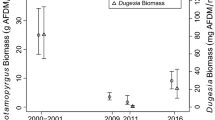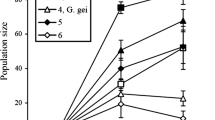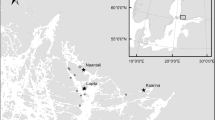Abstract
Understanding population dynamics and population regulation of invasive species is critical for predicting their effects on native ecosystems as well as for control strategies. Many species of gastropod in the genus Pomacea are successful aquatic invaders that have caused economic and ecological impacts in Southeastern Asia where their large fecundity and broad reproductive window helps them to colonize and take advantages of ephemeral agricultural habitats. We followed the population dynamics of P. insularum in permanent, stable freshwater systems (ponds and streams), and in ephemeral agricultural habitats in the upper Texas Gulf Coast region, USA. We found that although P. insularum has a large reproductive potential, its density, biomass and size structure in stable permanent systems did not change significantly from March to November, and densities averaged <2 m−2. This same species, however, displayed very different population dynamics in ephemeral agricultural environments. We found high densities (>130 m−2), and no stable size structure through time. Differences in the stability and persistence of these two types of environments appear to drive these patterns. Stability and persistence of habitats can result in different predator communities and the risk of predation for snails. We suggest that such factors may cause the differences in population dynamics and structure observed. The ability of snails to escape population control and explode in ephemeral habitats could drive the types of impacts seen on agricultural crops.




Similar content being viewed by others
References
Anderson B (1993) The Philippine snail disaster. Ecologist 23:70–72
Andrews EB (1965a) The functional anatomy of the gut of the prosobranch gastropod Pomacea canaliculata and of some other pilids. Proc Zool Soc Lond 145:19–36
Andrews EB (1965b) The functional anatomy of the mantle cavity, kidney, and blood system of some pilid gastropods (Prosobranchia). J Zool 146:70–94
Bachmann A (1960) Apuntes para una hidrobiología Argentina. II. Ampullaria insularum Orb. y A. canaliculata Lam. (Moll. Prosobr., Ampullaridae). Observaciones biológicas y ecológicas. In: Congreso Sudamericano de Zoología 1, October 12–24, 1959, Actas y Trabajos, vol 1. La Plata, Argentina, pp 19–26
Burlakova LE, Karatayev AY, Padilla DK, Cartwright LD, Hollas DN (2009) Wetland restoration and invasive species: applesnail (Pomacea insularum) feeding on native and invasive aquatic plants. Restor Ecol 17(3):433–440
Carlsson NOL, Lacoursière JO (2005) Herbivory on aquatic vascular plants by the introduced golden apple snail (Pomacea canaliculata) in Lao PDR. Biol Invasions 7:233–241
Carlsson NOL, Brönmark C, Hansson LA (2004) Invading herbivory: the golden apple snail alters ecosystem functioning in Asian wetlands. Ecology 85:1575–1580
Cazzaniga NJ (2006) Pomacea canaliculata: harmless and useless in its natural realm (Argentina). In: Joshi RC, Sebastian LS (eds) Global advances in ecology and management of golden apple snails. Philippine Rice Research Institute, Nueva Ecija, pp 37–60
Cowie RH (2002) Apple snails as agricultural pests: the biology, impacts, and management. In: Barker GM (ed) Molluscs as crop pests. CABI, Wallingford, pp 1–28
Dela Cruz MS, Joshi RC, Martin AR (2001) Basal application of fertilizer reduces golden apple snail population. IRRN 26:20–21
Donnay TJ, Beissinger SR (1993) Apple snail (Pomacea dolioides) and freshwater crab (Dilocarcinus dentatus) population fluctuations in the lanos of Venezuela. Biotropica 25:206–214
Estebenet AL (1995) Food and feeding in Pomacea canaliculata (Gastropoda: Ampullariidae). Veliger 38:277–283
Estebenet AL, Cazzangia NJ (1992) Growth and demography of Pomacea canaliculata (Gastropoda: Ampullariidae) under laboratory conditions. Malacol Rev 25:1–12
Halwart M (1994) The golden apple snail Pomacea canaliculata in Asian rice-farming systems: present impact and future threat. Int J Pest Manage 40:199–206
Halwart M (2006) Fish as biological control agents of golden apple snails in Philippine rice fields. In: Joshi RC, Sebastian LS (eds) Global advances in ecology and management of golden apple snails. Philippine Rice Research Institute, Nueva Ecija, pp 363–374
Halwart M, Bartley DM (2006) International mechanisms for the control and responsible use of alien species in aquatic ecosystems, with special reference to the golden apple snail. In: Joshi RC, Sebastian LS (eds) Global advances in ecology and management of golden apple snails. Philippine Rice Research Institute, Nueva Ecija, pp 449–458
Halwart M, Viray MC, Kaule G (1998) Cyprinus carpio and Oreochromis niloticus as biological control agents of the Golden Apple Snail Pomacea canaliculata—effects of predator size, prey size and prey density. Asian Fish Sci 11:31–42
Hayes KA, Joshi RC, Tiengo SC, Cowie RH (2008) Out of South America: multiple origins of non-native apple snails in Asia. Divers Distrib 14:701–712
Hengeveld R (1989) Dynamics of biological invasions. Chapman and Hall, London
Howells RG, Burlakova LE, Karatayev AY, Marfurt RK, Burks RL (2006) Native and introduced Ampullariidae in North America: history, status, and ecology. In: Joshi RC, Sebastian LS (eds) Global advances in ecology and management of golden apple snails. Philippine Rice Research Institute, Nueva Ecija, pp 73–112
Huffaker CB, Berryman AD, Laing JE (1984) Natural control of insect populations. In: Huffaker CB, Rabb RL (eds) Ecological entomology. Wiley, New York, pp 359–398
Hylton-Scott MI (1958) Estudio morfológico y taxonómico de los ampulláridos de la República Argentina. Rev Mus Argent Cienc Nat Bernardino Rivadavia Inst Nac Invest Cienc Nat (Argent) (Zool) 3:233–333
Ichinoise K, Wada T, Yusa Y, Kubota T (2000) Influence of habitat differences brought about by environmental changes on the densities of adults and eggs of Pomacea canaliculata. Kyushu Pl Prot Res 16:78–84
Ichinose K, Tochihara M, Wada T, Suguiura N, Yusa Y (2002) Influence of common carp on apple snail in a rice field evaluated by a predator-prey logistic model. Int J Pest Manage 48:133–138
Joshi RC, Sebastian LS (eds) (2006) Global advances in ecology and management of golden apple snails. Philippine Rice Research Institute, Nueva Ecija
Keawjam RS (1986) The apple snails of Thailand: distribution, habits and shell morphology. Malacol Rev 19:61–81
Krebs CJ (2001) Ecology: the experimental analysis of distribution and abundance, 5th edn. Benjamin Cummings, Menlo Park
Krebs CJ (2002) Beyond population regulation and limitation. Wildl Res 29:1–10
Lach L, Britton DK, Rundell RJ, Cowie RH (2000) Food preference and reproductive plasticity in an invasive freshwater snail. Biol Invasions 2:279–288
Louda SM, McKaye KR (1982) Diurnal movements in populations of the prosobranch Lanistesnuassanus at Cape Maclear, Lake Malawi, Africa. Malacologica 23:13–21
Louisiana Rice Production Handbook (2005) Available via Louisiana State University Agricultural Center, Baton Rouge, Louisiana. http://www.lsuagcenter.com/en/crops_livestock/crops/rice/Publications/Rice+Production+Handbook.htm. Cited 3 Oct 2008
Lowe S, Browne M, Boudjelas S (2000) 100 Of the world’s worst invasive alien species. Invasive Species Specialist Group, Auckland, p 12
Mack RN, Simberloff D, Lonsdale WM, Evans H, Clout M, Bazzaz FA (2000) Biotic invasions: causes, epidemiology, global consequences, and control. Ecol Appl 10:689–710
Manly B (1992) The design and analysis of research studies. Cambridge University Press, Cambridge
Martin PR, Estebenet AL, Cazzaniga NJ (2001) Factors affecting the distribution of Pomacea canaliculata (Gastropoda: Ampullariidae) along its southernmost natural limit. Malacologia 43:13–43
Matienzo LH (1984) Wilson Ang’s big food snails. Freenfields 14:24–29
Mochida O (1991) Spread of freshwater Pomacea snails (Pilidae, Mollusca) from Argentina to Asia. Micronesia Suppl 3:51–62
Murray BG Jr (1979) Population dynamics: alternative models. Academic Press, New York
Naylor R (1996) Invasions in agriculture: assessing the cost of the golden apple snail in Asia. Ambio 25:443–448
Parker IM, Simberloff D, Lonsdale WM, Goodell K, Wonham M, Kareiva PM, Williamson MH, Von Holle V, Moyle PB, Byers JE, Goldwasser L (1999) Impact: toward a framework for understanding the ecological effect of invaders. Biol Invasions 1:2–19
Ramcharan CW, Padilla DK, Dodson SI (1992) Models to predict potential occurrence and density of the zebra mussel, Dreissena polymorpha. Can J Fish Aquat Sci 49:2611–2620
Ranamukhaarachchi L, Wickramasinghe S (2006) Golden apple snails in the world: introduction, impact, and control measures. In: Joshi RC, Sebastian LS (eds) Global advances in ecology and management of golden apple snails. Philippine Rice Research Institute, Nueva Ecija, pp 133–152
Rawlings TA, Hayes KA, Cowie RH, Collins TM (2007) The identity, distribution, and impacts of non-native apple snails in the continental United States. BMC Evol Biol 7:97
Sanico AL, Peng S, Laza RC, Visperas RM (2002) Effect of seedling age and seedling number per hill on snail damage in irrigated rice. Crop Prot 21:137–143
Simberloff D, Gibbons L (2004) Now you see them, now you don’t!—population crashes of established introduced species. Biol Invasions 6:161–172
Snyder NFR, Snyder HA (1971) Defenses of the Florida apple snail Pomacea paludosa. Behavior 40:7–10
Teo SS (2001) Evaluation of different duck varieties for the control of the golden apple snail (Pomacea canaliculata) in transplanted and direct seeded rice. Crop Prot 20:599–604
Teo SS (2003) Damage potential of the golden apple snail Pomacea canaliculata (Lamarck) in irrigated rice and its control by cultural approaches. Int J Pest Manage 49:49–55
Texas Rice Production Guidelines (2008) Available via Texas A&M University System AgriLife Research and Extension Center at Beaumont, Texas. http://beaumont.tamu.edu/eLibrary/publications_default.htm. Cited 3 Oct 2008
Turchin P (1999) Population regulation: a synthetic view. Oikos 84:153–159
Vega RSA, Villancio VT, Mendoza PA, Limosinero RL, Mendoza TC (1992) Agro-economic evaluation ofnon-chemical control method against golden apple snail (Pomacea canaliculata) in irrigated lowland rice. Philipp J Crop Sci 16(Suppl. 1):9
Wada T (1999) The Apple snail, Pomacea canaliculata (Lamarck) in South America: its rice damage and natural enemies. Plant Prot 53:273–277
Wada T (2004) Strategies for controlling the apple snail Pomacea caniculata (Lamarck) (Gastropoda: Ampullariidae) in Japanese direct-sown paddy fields. JARQ 38:75–80
Wada T (2006) Impact and control of introduced Apple Snail, Pomacea canaliculata (Lamarck), in Japan. In: Joshi RC, Sebastian LS (eds) Global advances in ecology and management of golden apple snails. Philippine Rice Research Institute, Nueva Ecija, pp 181–198
Wada T, Ichinose K, Yusa Y, Sugiura N (2004) Decrease in density of the apple snail Pomacea canaliculata (Lamarck) (Gastropoda: Ampullariidae) in paddy fields after crop rotation with soybean, and its population growth during the crop season. Appl Entomol Zool 39:367–372
Yusa YN (2006) Predators of the introduced Apple Snail, Pomacea canaliculata (Gastropoda: Ampullariidae): their effectiveness and utilization in biological control. In: Joshi RC, Sebastian LS (eds) Global advances in ecology and management of golden apple snails. Philippine Rice Research Institute, Nueva Ecija, pp 133–392
Yusa Y, Sugiura N, Wada T (2006) Predatory potential of freshwater animals on an invasive agricultural pest, the apple snail Pomacea canaliculata (Gastropoda: Ampullariidae), in southern Japan. Biol Invasions 8:137–147
Zenkevich LA (1940) About acclimatization in the Caspian Sea new invertebrates as a food for fishes and theoretical background for this. Bull Soc Nat Moscow 39:18–30 (in Russian)
Acknowledgments
This research was supported by grant number 414197 from US Fish and Wildlife Service, and Galveston Bay Estuary Program, Texas Commission on Environmental Quality. We thank the managers and staff at the Chambers County Golf Course for facilitating monthly sampling of Pomacea insularum at their facility. We appreciate the help of Mark Kramer and Ann Brinly (Armand Bayou Nature Center), Jeff DallaRosa (Galveston Bay Estuary Program, Texas Commission on Environmental Quality), Ronny Dumesnil and Curt Mowery, Robert G. Howells, students from Stephen F. Austin State University (Nacogdoches, Texas) Amanda Camp, Edgardo Avelar, Daniel Bennett and Olga Minich; Rodrigo Menezes (Conroe ISD Academy of Science and Technology, Woodlands, Texas); Pudge Willcox (Chambers-Liberty Counties Navigation District, Anahuac, Texas), and John K. Saichuk (Louisiana State University AgCenter). We thank Ronny Dumesnil, Michael J. Stout (Louisiana State University) and M. O. Way (Texas A&M University System AgriLife Research and Extension Center at Beaumont) for helpful suggestions on earlier versions of this manuscript. LEB was supported by Research Foundation of SUNY and acknowledges a grant from Buffalo State College Research Council Incentive Funds (Award # 32918 to AYK and LEB). We are very thankful to the referees for their valuable comments that helped to improve the manuscript.
Author information
Authors and Affiliations
Corresponding author
Rights and permissions
About this article
Cite this article
Burlakova, L.E., Padilla, D.K., Karatayev, A.Y. et al. Differences in population dynamics and potential impacts of a freshwater invader driven by temporal habitat stability. Biol Invasions 12, 927–941 (2010). https://doi.org/10.1007/s10530-009-9513-5
Received:
Accepted:
Published:
Issue Date:
DOI: https://doi.org/10.1007/s10530-009-9513-5




